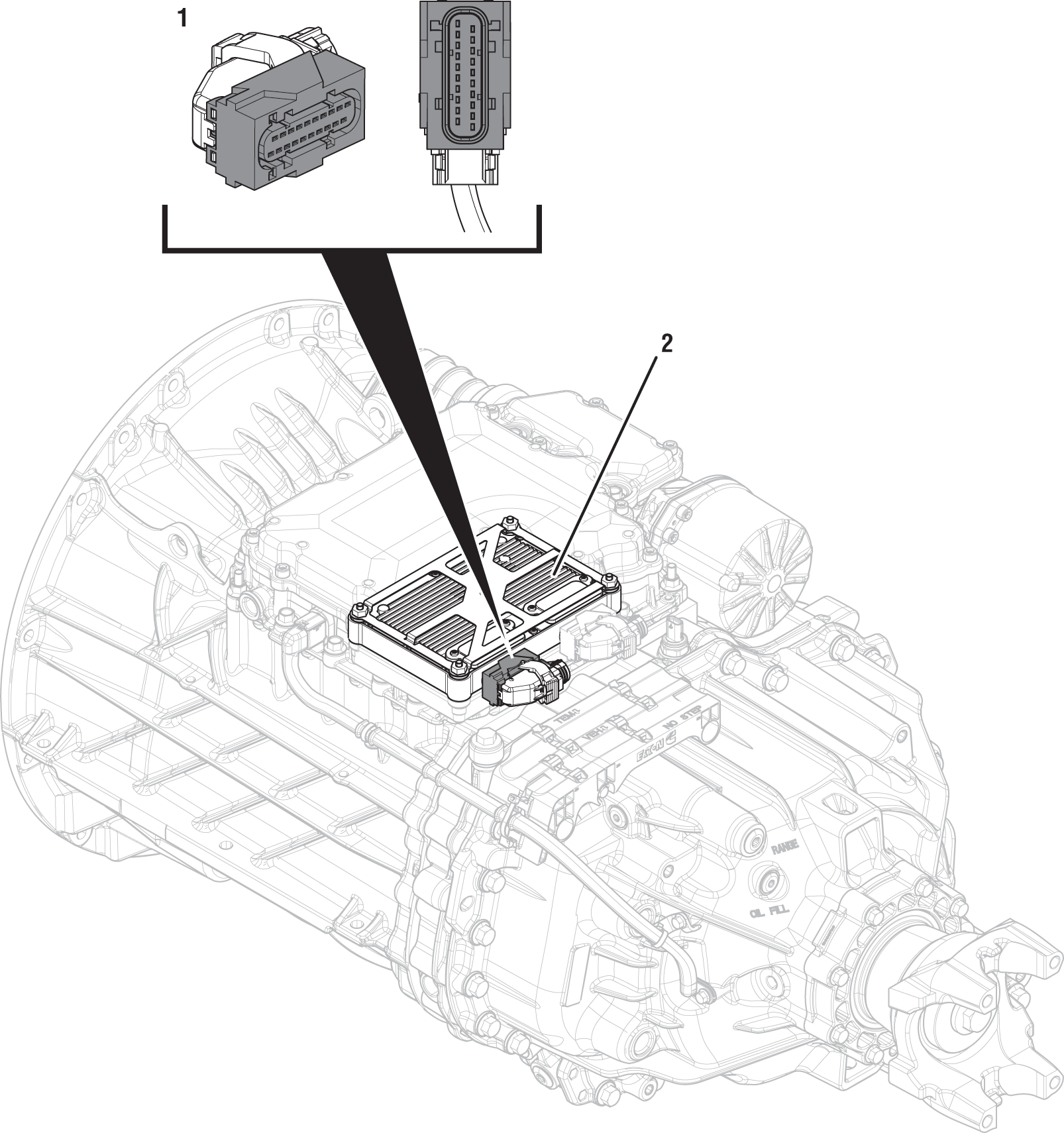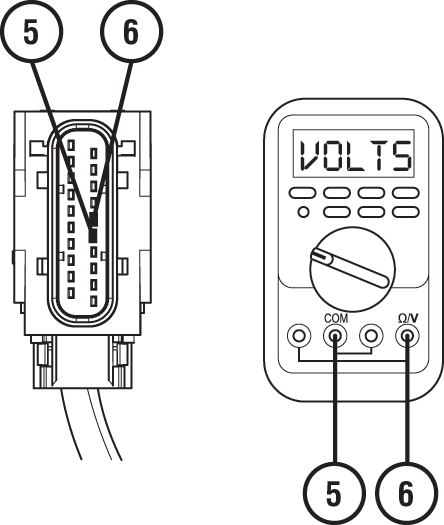Fault Code 100: Battery Voltage1
J1939: SA 3 SPN 168 FMI 0, 1, 4, 17, 18
Overview
The Transmission Control Module (TCM) requires a battery power and ground supply. The TCM has redundant power and ground sources (Battery Voltage1 and Battery Voltage2) that maintain normal function if either source becomes unavailable. The Battery Voltage1 wiring connects to the TCM through the 20-Way TCM Vehicle Harness Connector.
Detection
The TCM monitors Battery Voltage1 power and ground source. If the voltage is out of range, the fault is set Active.
Conditions to Set Fault Code Active
FMI 0 – Data Valid But Above Normal (Most Severe): Battery Voltage1 greater than 16.5 volts for 5 seconds.
FMI 1 – Data Valid But Below Normal (Most Severe): Battery Voltage1 less than 8 volts for 1 second.
FMI 4 – Voltage Below Normal or Shorted Low: Battery Voltage1 less than 4 volts during power up.
FMI 17 – Data Valid But Below Normal (Least Severe): Battery Voltage1 less than 11V for 5 seconds with engine above 1000 RPM.
FMI 18 – Data Valid But Below Normal (Moderately Severe): Battery Voltage1 less than 10.2 volts for 1 second with engine above 550 RPM.
Fallback
FMI 0:
- No degraded modes
FMI 1, 18:
- Amber warning lamp on
- If Fault Code 100 and 105 are both Active and transmission is in gear:
- Coast Mode and Neutral Coast prohibited
- Urge to Move and Creep Mode prohibited
- Inertia Brake activation prohibited
- Upshifts prohibited
- Clutch engagements prohibited
- Non-Neutral modes prohibited
- PTO Mode prohibited
- If Fault Code 100 and 105 are both Active and transmission is not in gear:
- Coast Mode and Neutral Coast prohibited
- Urge to Move and Creep Mode prohibited
- Inertia Brake activation prohibited
- Upshifts prohibited
- Clutch disengagements prohibited
- Non-Neutral modes prohibited
- PTO Mode prohibited
- If vehicle is moving - Red stop lamp on
FMI 4, 17:
- Amber warning lamp on
- No degraded modes
Conditions to Set Fault Code Inactive
FMI 0, 1, 17, 18: Battery Voltage1 in range for 10 seconds.
FMI 4: Key cycle and fault condition no longer exist.
Possible Causes
FMI 0:
- Vehicle jump-started
- Vehicle charging/battery system failure
FMI 1, 4, 17, 18:
- Vehicle Harness - Battery Power Supply
- Wiring shorted to power, shorted to ground or open
- Terminals bent, spread, corroded, or loose
- Vehicle charging/battery system failure
Note: Refer to OEM for troubleshooting a failed system.
Additional Tools
- Endurant XD Service Manual TRSM0960
- Digital Volt Ohm Meter (DVOM)
Component Identification
 |
1. 20-Way TCM Vehicle Harness Connector 2. Transmission Control Module (TCM) |
 |
1. Transmission Control Module (TCM) 2. 20-Way TCM Vehicle Harness Connector 3. In-line Fuse Holder Battery Voltage1 4. 15-amp Fuse Battery 1 |
 |
Fault Code 100 Troubleshooting
Set vehicle parking brake and chock wheels.
Record transmission fault codes, FMIs, occurrences, and timestamps from Service Activity Report created during the Diagnostic Procedure.
If Fault Code 100 is Inactive and there are other Active vehicle or transmission fault codes, troubleshoot all Active fault codes. Go to Step V
If Fault Code 100 FMI 0 is Active, Go to Step F
If Fault Code 100 FMI 0 is Inactive, the TCM experienced an over-voltage condition. Vehicle may have been jump-started or vehicle charging/battery system is failing. Refer to OEM guidelines for repair or replacement of vehicle charging/battery system. Go to Step V
If Fault Code 100 FMI 1, 17, 18 is Active or Inactive, Go to Step B
If Fault Code 100 FMI 4 is Active or Inactive, create a Service Activity Report, select "Send to Eaton" and contact Eaton Cummins Auto-mated Transmission Technologies at +1 800-826-4357 for further diagnostic instructions. Go to Step V
Key on with engine off.
Connect ServiceRanger.
Go To “Data Monitor”.
From "Default Parameter Files" tab select “Transmission Supplied Voltages”.
Monitor 168 - "Battery voltage" value. Record reading in table.
Monitor 444 - "Battery 2 voltage" value. Record reading in table.
Compare reading(s) in table.
If readings are out of range, Go to Step C
If readings are in range and no fault was found, the intermittent nature of the fault makes it likely there is a wiring problem between the vehicle charging/battery system and 20-Way TCM Vehicle Connector. Refer to OEM guidelines for repair or replacement of the vehicle harness and/or 20-Way TCM Vehicle Harness Connector. Go to Step V
| Parameter | Range | Readings |
|---|---|---|
| 168 - Battery voltage | 11-15V | |
| 444 - Battery 2 voltage | 11-15V |
Key off.
Inspect vehicle charging/battery system and fuses, verify connectors are free from contamination and corrosion; terminals are not bent, spread or loose; and there is no damage to connector bodies.
If no fault found, Go to Step D
If fault found, refer to OEM guidelines for repair or replacement of vehicle charging/battery system. Go to Step V
Note: Some chassis use a power distribution system separate from batteries, inspect all connections.
Key off.
Disconnect 20-Way TCM Vehicle Harness Connector from TCM.
Inspect 20-Way TCM Vehicle Harness Connector, verify connector is free from contamination and corrosion; terminals are not bent, spread or loose; and there is no damage to connector body.
Inspect 20-Way TCM Vehicle Connector, verify connector is free from contamination and corrosion; terminals are not bent, spread or loose; and there is no damage to connector body.
If contamination or damage is found, refer to OEM guidelines for repair or replacement of 20-Way TCM Vehicle Harness Connector. Go to Step V
If no contamination or damage is found, Go to Step E
Key off.
Measure voltage between 20-Way TCM Vehicle Harness Connector Pin 5 (-) and Pin 6 (+). Record reading in table.

Compare reading(s) in table:
If readings are out of range, refer to OEM guidelines for repair or replacement of the vehicle charging/battery system, vehicle harness and/or 20-Way TCM Vehicle Harness Connector. Go to Step V
If readings are in range and no fault was found, the intermittent nature of the fault makes it likely there is a wiring problem between the vehicle charging/battery system and 20-Way TCM Vehicle Connector. Refer to OEM guidelines for repair or replacement of vehicle harness and/or 20-Way TCM Vehicle Harness Connector. Go to Step V
| Pins | Range | Reading(s) |
|---|---|---|
| 5 to 6 | 11–15V |
Key on with engine off.
Connect ServiceRanger.
Go To “Data Monitor.”
From "Default Parameter Files" tab select “Transmission Supplied Voltages”.
Monitor 168 - "Battery voltage" value. Record reading in table.
Monitor 444 - "Battery 2 voltage" value. Record reading in table.
Key on with engine running.
Monitor 168 - "Battery voltage" value. Record reading in table.
Monitor 444 - "Battery 2 voltage" value. Record reading in table.
Compare reading(s) in table.
If readings are out of range, refer to OEM guidelines for repair or replacement of the vehicle charging/battery system. Go to Step V
If readings are in range and Fault Code 100 FMI 0 is Inactive, vehicle may have been jump-started or the intermittent nature of the fault makes it likely that the problem is in the vehicle charging/battery system. Refer to OEM guidelines for diagnosing vehicle charging/battery system. Go to Step V
If readings are in range and Fault Code 100 FMI 0 is Active, replace Transmission Control Module (TCM). Go to Step V.
Note: If troubleshooting indicated no fault found in wiring or connections to TCM, ensure an intermittent issue does not exist in wiring or connections before replacing TCM.
| Condition | Parameter | Range | Reading(s) |
|---|---|---|---|
| Key on with engine off | 168 - Battery voltage | 11–13V | |
| Key on with engine off | 444 - Battery 2 voltage | 11–13V | |
| Key on with engine running | 168 - Battery voltage | 13–15V | |
| Key on with engine running | 444 - Battery 2 voltage | 13–15V |
Key off.
Reconnect all connectors and verify all components are properly installed.
Key on with engine off.
Connect ServiceRanger.
Go To “Fault Codes”.
Select “Clear All Faults”.
Operate vehicle and attempt to reset the fault code or duplicate the previous complaint.
Check for fault codes using ServiceRanger.
If no fault codes set and vehicle operates properly, test complete.
If Fault Code 100 sets Active, Go to Step A
If a fault code other than 100 sets Active, troubleshoot per the Fault Code Isolation Procedure Index.